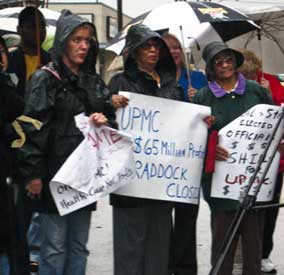Pittsburgh protesters say: ‘Save Braddock Hospital’
By
Cheryl LaBash
Pittsburgh
Published Dec 5, 2009 10:53 AM
Undaunted by pouring rain, hundreds of community residents, students and United
Steelworker union retirees in Pittsburgh blocked the street in front of the
Braddock hospital on Nov. 19 to declare that the struggle to keep the facility
open was only the beginning.
The University of Pittsburgh Medical Center slated the closing of the
103-year-old hospital as it began construction on a $250 million hospital in
Monroeville, Pa., adjacent to a competing hospital in a more economically
upscale area. UPMC’s decision to close Braddock as of Jan. 31, 2010,
takes place during the nationwide fight to win health care for all against the
interests of insurance companies, pharmaceutical giants and health care
behemoths like UPMC, all of whom are determined to keep their profit margins
growing.
Both single-payer universal health care organizers and the Steelworkers union
see the fight to keep UPMC Braddock hospital open as a front line in the fight
for quality, accessible and affordable health care for all.
Steelworkers International Vice-President Fred Redmond spoke from the back of
the flatbed-truck stage. He said, “UPMC has made a unilateral decision to
remove this hospital from this community—take away trauma care, take away
prenatal care, take away care from the people who need it the most. This is a
broken system. ... We are going to do everything that is humanly possible to
try to change the mind of this multinational corporation, UPMC—a billion
dollar corporation, a corporation that has made a decision to close this
hospital based on profit as opposed to people. ... Let’s remain focused
to see to it that the people of Braddock have a health care facility that they
can rely on. That the people in Braddock are not second class citizens and the
UPMC puts back the money into the community that has made them rich over the
years by keeping this hospital open.”
Other speakers included the current USW local president from the Edgar Thomson
Steel Works, whose smokestacks loom just a couple of blocks from the hospital.
He pointed out that the nearby emergency room at UPMC Braddock means life or
death for any worker suffering an industrial accident at the mill.
Speakers echoed the many signs held by protesters noting that UPMC CEO Jeffrey
Romoff pulls down $4.45 million per year heading the nonprofit—thus tax
exempt—medical giant attempting to pull the plug on UPMC Braddock.
In what would challenge the general view of what not-for-profit means, the UPMC
Web site describes itself this way: “UPMC is an $8 billion integrated
global health enterprise headquartered in Pittsburgh, Pennsylvania, and one of
the leading nonprofit health systems in the United States. As western
Pennsylvania’s largest employer, with 50,000 employees, UPMC is
transforming the economy of the region into one based on medicine, research and
technology. By integrating 20 hospitals, 400 doctors’ offices and
outpatient sites, long-term care facilities and a major health insurance
services division, and in collaboration with its academic partner, the
University of Pittsburgh Schools of the Health Sciences, UPMC has advanced the
quality and efficiency of health care and developed internationally renowned
programs in transplantation, cancer, neurosurgery, psychiatry, orthopedics, and
sports medicine, among others. UPMC is commercializing its medical and
technological expertise by nurturing new companies, developing strategic
business relationships with some of the world’s leading multinational
corporations and expanding into international markets, including Italy,
Ireland, the United Kingdom, Cyprus, and Qatar.”
Braddock is a small, very poor town along the banks of the Monongahela River,
adjacent to Pittsburgh and the home of Carnegie’s first mill, now with
fewer than 3,000 residents, down from its peak of 20,000. Similar small
communities like Rankin, Wilkinsburg, Homestead and McKeesport, broken by the
destruction of the area’s steel jobs, now receive refugees from
Pittsburgh’s much lauded rebirth, which is being effected through the
gentrification of primarily African-American neighborhoods in the Hill District
and the Northside, where sports stadiums gleam.
Already the Wilkinsburg City Council has unanimously voted to support the fight
to keep UPMC Braddock open, pointing out that Wilkinsburg has no emergency
room. Braddock Mayor Fetterman reported that officials in Turtle Creek, North
Braddock, Munhall, Rankin, Forest Hills, Homestead, West Homestead and
Swissvale are supporting the campaign, which will include petitioning in
Pittsburgh and protests at UPMC headquarters and its CEO’s personal
residence as well as possible legal action.
Articles copyright 1995-2012 Workers World.
Verbatim copying and distribution of this entire article is permitted in any medium without royalty provided this notice is preserved.
Workers World, 55 W. 17 St., NY, NY 10011
Email:
[email protected]
Subscribe
[email protected]
Support independent news
DONATE


